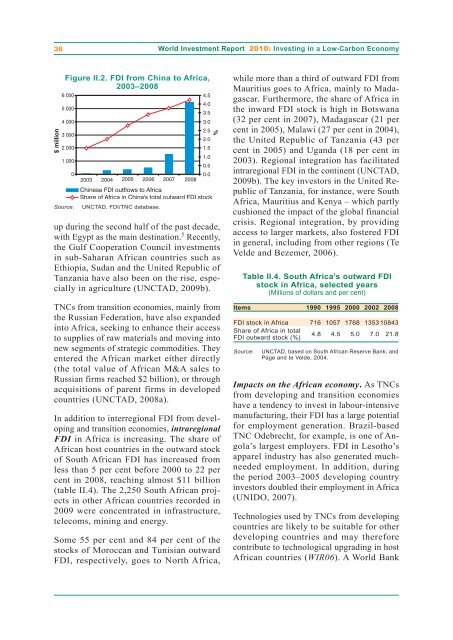UN World Investment Report 2010 - Office of Trade Negotiations
UN World Investment Report 2010 - Office of Trade Negotiations
UN World Investment Report 2010 - Office of Trade Negotiations
Create successful ePaper yourself
Turn your PDF publications into a flip-book with our unique Google optimized e-Paper software.
36<br />
$ million<br />
Figure II.2. FDI from China to Africa,<br />
2003–2008<br />
6 000<br />
5 000<br />
4 000<br />
3 000<br />
2 000<br />
1 000<br />
0<br />
2003 2004 2005 2006 2007 2008<br />
Source: <strong>UN</strong>CTAD, FDI/TNC database.<br />
<strong>World</strong> <strong>Investment</strong> <strong>Report</strong> <strong>2010</strong>: Investing in a Low-Carbon Economy<br />
4.5<br />
4.0<br />
3.5<br />
3.0<br />
2.5<br />
2.0<br />
1.5<br />
1.0<br />
0.5<br />
0.0<br />
Chinese FDI outflows to Africa<br />
Share <strong>of</strong> Africa in China's total outward FDI stock<br />
%<br />
up during the second half <strong>of</strong> the past decade,<br />
with Egypt as the main destination. 5 Recently,<br />
the Gulf Cooperation Council investments<br />
in sub-Saharan African countries such as<br />
Ethiopia, Sudan and the United Republic <strong>of</strong><br />
Tanzania have also been on the rise, especially<br />
in agriculture (<strong>UN</strong>CTAD, 2009b).<br />
TNCs from transition economies, mainly from<br />
the Russian Federation, have also expanded<br />
into Africa, seeking to enhance their access<br />
to supplies <strong>of</strong> raw materials and moving into<br />
new segments <strong>of</strong> strategic commodities. They<br />
entered the African market either directly<br />
(the total value <strong>of</strong> African M&A sales to<br />
Russian firms reached $2 billion), or through<br />
acquisitions <strong>of</strong> parent firms in developed<br />
countries (<strong>UN</strong>CTAD, 2008a).<br />
In addition to interregional FDI from developing<br />
and transition economies, intraregional<br />
FDI in Africa is increasing. The share <strong>of</strong><br />
African host countries in the outward stock<br />
<strong>of</strong> South African FDI has increased from<br />
less than 5 per cent before 2000 to 22 per<br />
cent in 2008, reaching almost $11 billion<br />
(table II.4). The 2,250 South African projects<br />
in other African countries recorded in<br />
2009 were concentrated in infrastructure,<br />
telecoms, mining and energy.<br />
Some 55 per cent and 84 per cent <strong>of</strong> the<br />
stocks <strong>of</strong> Moroccan and Tunisian outward<br />
FDI, respectively, goes to North Africa,<br />
while more than a third <strong>of</strong> outward FDI from<br />
Mauritius goes to Africa, mainly to Madagascar.<br />
Furthermore, the share <strong>of</strong> Africa in<br />
the inward FDI stock is high in Botswana<br />
(32 per cent in 2007), Madagascar (21 per<br />
cent in 2005), Malawi (27 per cent in 2004),<br />
the United Republic <strong>of</strong> Tanzania (43 per<br />
cent in 2005) and Uganda (18 per cent in<br />
2003). Regional integration has facilitated<br />
intraregional FDI in the continent (<strong>UN</strong>CTAD,<br />
2009b). The key investors in the United Republic<br />
<strong>of</strong> Tanzania, for instance, were South<br />
Africa, Mauritius and Kenya – which partly<br />
cushioned the impact <strong>of</strong> the global financial<br />
crisis. Regional integration, by providing<br />
access to larger markets, also fostered FDI<br />
in general, including from other regions (Te<br />
Velde and Bezemer, 2006).<br />
Table II.4. South Africa’s outward FDI<br />
stock in Africa, selected years<br />
(Millions <strong>of</strong> dollars and per cent)<br />
Items 1990 1995 2000 2002 2008<br />
FDI stock in Africa 716 1057 1768 135310843<br />
Share <strong>of</strong> Africa in total<br />
FDI outward stock (%)<br />
4.8 4.5 5.0 7.0 21.8<br />
Source: <strong>UN</strong>CTAD, based on South African Reserve Bank; and<br />
Page and te Velde, 2004.<br />
Impacts on the African economy. As TNCs<br />
from developing and transition economies<br />
have a tendency to invest in labour-intensive<br />
manufacturing, their FDI has a large potential<br />
for employment generation. Brazil-based<br />
TNC Odebrecht, for example, is one <strong>of</strong> Angola’s<br />
largest employers. FDI in Lesotho’s<br />
apparel industry has also generated muchneeded<br />
employment. In addition, during<br />
the period 2003–2005 developing country<br />
investors doubled their employment in Africa<br />
(<strong>UN</strong>IDO, 2007).<br />
Technologies used by TNCs from developing<br />
countries are likely to be suitable for other<br />
developing countries and may therefore<br />
contribute to technological upgrading in host<br />
African countries (WIR06). A <strong>World</strong> Bank

















